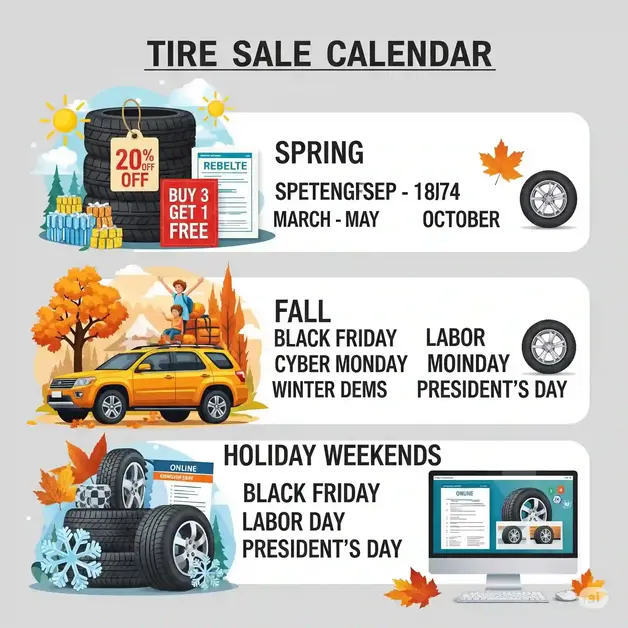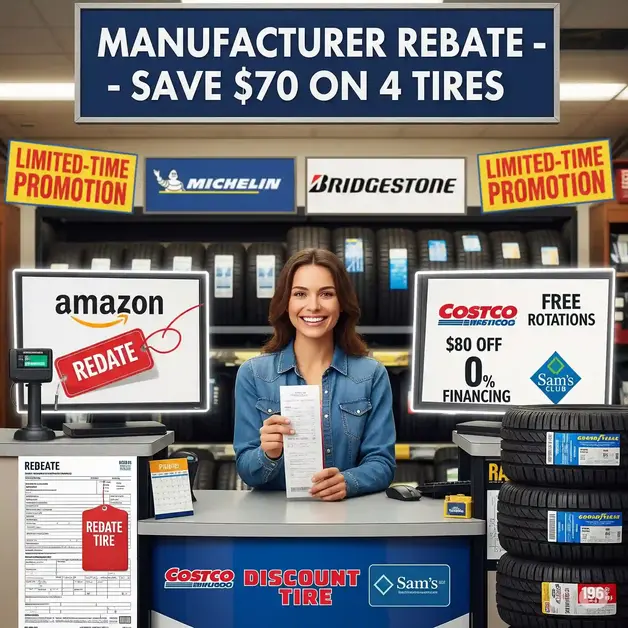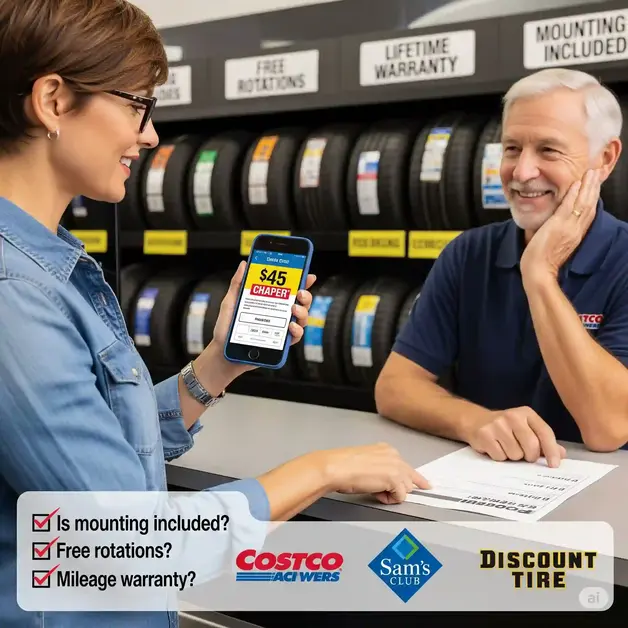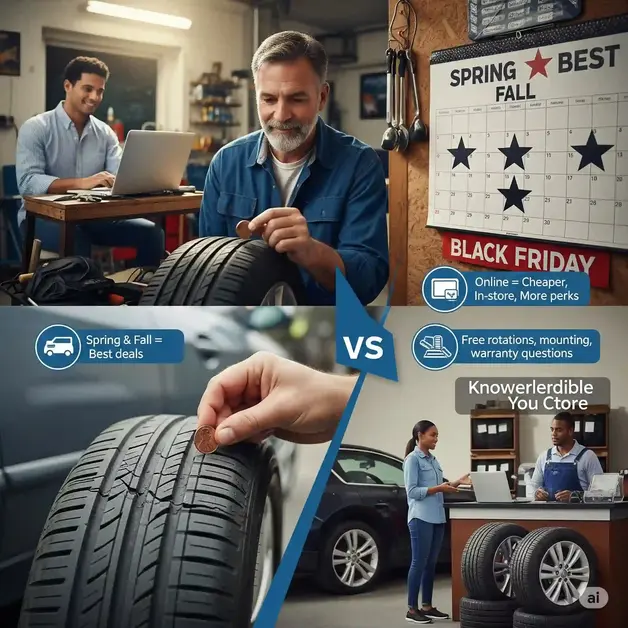Ever asked yourself when is the best time to buy tires? I used to think any time my tread looked worn was the right time—but I quickly learned that timing can save you real money and hassle. In fact, knowing when is the best time of year to buy tires helped me avoid paying full price more than once. Over the years, I’ve picked up a few tricks from personal experience and long talks with tire shop guys who’ve seen it all. In this guide, I’ll share what I’ve learned—so you know when to buy new tires without second-guessing. Let’s dive in and make sure your next tire purchase feels smart, safe, and budget-friendly.
Why Tire Timing Matters
You know, I used to think tires were just something you replaced when they looked bad or felt weird. If the tread was low or the car slid a bit in the rain, I’d figure, “Alright, time to buy new ones.” But I quickly learned that waiting until you need tires can actually cost more—and not just money.
I remember one time I got a flat out of nowhere. I was late for work, it was raining, and every tire shop nearby was quoting full price. No discounts, no promotions—just “take it or leave it.” That’s when it hit me:
Buying tires in a rush is like buying an umbrella in a thunderstorm—you’re going to overpay and still be wet.
Here’s the thing: the best time to buy tires isn’t when you need them—it’s before that. When you’re not in a rush, you get to choose. You get to look at deals, compare shops, and even ask questions like, “Is mounting included?” or “Do I get free rotations?” That’s peace of mind money can’t buy.
Also, timing matters for safety. If you live where it snows or rains a lot, worn tires can turn a normal road into a skating rink. I’ve felt that little heart-drop moment when the car slides just a second longer than it should. It’s scary—and it’s a clear reminder that waiting too long can put you and others at risk.
So if you’re wondering why tire timing matters, the answer is simple: you save money, avoid stress, and drive safer. Tire prices aren’t the same all year, and certain months—like spring and fall—often bring better deals and fresh stock. If you plan just a bit ahead, your tires (and your wallet) will thank you.
And honestly, once I started watching for tire sales and paying attention to seasonal trends, I never paid full price again. It feels good to drive away knowing you got a great deal and your car’s ready for whatever the road throws at you.
When Is The Best Time To Buy Tires?
Let me give it to you straight: the best time to buy tires is before you actually need them. That might sound obvious, but most of us—including me at one point—only think about tires after we notice something wrong. Maybe the tread looks low, or the car feels off in the rain. But by that point, it’s already a bit too late to shop smart.
Before You Actually Need Them
I learned this lesson the hard way. One rainy morning, I was rushing to work when I hit a deep puddle and my car fishtailed. The tires were nearly bald—I knew it, but I had put it off. That little slide gave me a wake-up call. I pulled into the nearest tire shop, soaking wet and desperate. No discounts, no time to compare—just me, a card swipe, and a big bill.
From that moment, I changed how I buy tires. I started planning ahead, treating tires like a seasonal purchase, not an emergency fix. When you’re not in a rush, you can shop around and catch a deal. You can compare prices, check warranty offers, and even ask if mounting and balancing are included. You’re in control—not just reacting.
And here’s something tire guys often say (and I’ve seen it play out): tire prices actually change throughout the year. They go up and down based on demand, season, and inventory shifts.
When Tire Sales Are at Their Peak
So, when should you look? From both research and real-world experience, I’ve found that spring and fall are ideal times to buy tires. Think about it—those are the seasons when people are either switching from winter to summer tires or getting ready for snow. Retailers know this, and they roll out deals to move inventory fast.
In spring, there are fresh promotions on all-season and summer tires as shops stock up for the driving season. Fall, on the other hand, is perfect for finding clearance deals on summer tires or prepping for winter with snow tire sales.
And don’t sleep on holiday weekends. Holiday weekends like Black Friday and Memorial Day often bring some of the biggest discounts of the year. I still remember scoring a full set of Goodyear Assurance tires on Cyber Monday for 25% off—with free installation thrown in. That deal would’ve never happened if I had waited for a tire to fail.
The best part of buying early is peace of mind. You know your car’s ready for road trips, bad weather, or just daily driving without worry. And your wallet stays happier too.
Best Times of Year to Buy Tires
If you’ve ever wondered when exactly to shop for new tires, I’ve got good news—the best times of year to buy tires are spring, fall, and holiday weekends. These aren’t just guesses. I’ve tested this with my own wallet, and tire shop pros will tell you the same thing: when the seasons change, so do tire prices.
Timing your tire purchase around these windows can save you real money and give you more options. Instead of grabbing whatever’s on the shelf during an emergency, you can choose based on performance, price, and warranty. Let me break down when the deals really roll in—and why these moments matter.
Spring Tire Promotions
Spring is when the world wakes up—and tire deals do too. After winter, most drivers start swapping out snow tires for all-season or summer ones. This shift creates a wave of sales as shops look to clear out old stock and promote new arrivals. I’ve found that March through May is perfect for finding solid discounts and wider selection.
Buying in spring also lines up with vacation planning. Whether you’re heading out on a road trip or just prepping for more miles in warmer weather, spring tire sales give you fresh rubber and peace of mind.
Why Spring?
Spring is a great time to buy tires. Why? Because it’s that sweet spot when winter ends and most drivers swap their snow tires for all-season or summer ones. Tire shops want to move fresh stock, and manufacturers often run national promotions.
Think of it like fashion—stores want last season’s stuff out before the new season fully kicks in. That means more sales and more selection. If you’re planning a road trip or just getting your car ready for warmer months, spring gives you the best mix of value and timing.
My Experience: Spring Savings on Touring Tires
A couple of years ago, I needed new touring tires for my sedan. I held out until March and started checking weekly flyers. That’s when I spotted a sale at a local tire shop—Michelin tires were 20% off, plus a rebate. I went in, asked a few questions, and ended up with a great deal and free tire rotations for the life of the set. That one spring purchase saved me over $120 just by being patient.
Fall Clearance Sales
When summer ends and cooler weather rolls in, tire shops start shifting their stock. Fall is a key season for tire clearance events. It’s when retailers begin moving out summer tires and preparing shelves for winter models. This seasonal transition makes September and October ideal months to score serious savings.
Plus, tire brands often offer fall incentives to boost year-end sales. If you time it right, you can grab a premium set at a discount—before winter driving makes things riskier and more expensive.
Why Fall Works
Fall is another golden window. Retailers are clearing out summer tire inventory to make room for winter tires. This seasonal shuffle creates big markdowns, especially in September and October. It’s like finding a winter coat on sale just before the first snow hits.
Plus, if you live in a colder climate, you know winter driving gets sketchy fast. Buying tires in the fall lets you prep ahead before icy roads catch you off guard.
Best Time for Snow Tire Shoppers
If you’re planning to buy snow tires, late October to early November is usually the perfect time. Wait too long, and you’ll be stuck with higher prices or limited options. I’ve seen folks scrambling in December when the first big storm hits, only to find their size is sold out everywhere. Don’t be that person. Beat the rush and shop early.
Holiday Tire Discounts
Holidays don’t just bring family gatherings and sales on TVs—they also bring some of the best tire deals you’ll find all year. If you can hold out for long weekends or end-of-year events, you’re likely to save big. I’ve seen buy-three-get-one-free offers, mail-in rebates, and even perks like free installations stacked on top.
Whether you’re shopping online or in-store, holiday promotions are a smart way to knock down the price of premium tires—especially if you already know the brand and size you want.
Key Sales Events
Some of the biggest tire discounts happen during major holidays. Think:
- Black Friday
- Cyber Monday
- President’s Day
- Labor Day
Tire shops—both online and local—join the holiday sale madness, and it’s the best time to snag high-quality tires at lower prices. I’ve even seen buy-three-get-one-free deals and mail-in rebates stacked on top of sale prices.
What I Noticed Buying Tires on Cyber Monday
I still remember buying tires online on Cyber Monday. I had my eye on a set of Goodyear all-terrains. That weekend, they dropped in price by $80, plus there was a $50 mail-in rebate. I placed the order, had them shipped to my local installer, and booked an appointment. Easy. No pressure. No up-selling. Just a quiet win.
Bottom line: The best times of year to buy tires are spring, fall, and holiday weekends.
These windows give you more choice, better pricing, and the freedom to plan—not panic. And when you shop early, you’re not just saving money—you’re upgrading safety, too.
Need tires now? Check tire deals on Amazon to compare prices, brands, and reviews all in one place.
Signs You Shouldn’t Wait Any Longer to Replace Tires
Sometimes we don’t notice tire problems until they become really obvious—but by then, the damage is already done. If your tires are worn out, you’re not just risking comfort—you’re risking your safety. Trust me, I’ve made the mistake of waiting too long before. You don’t want to find yourself hydroplaning on a rainy day or sliding in a turn just because you didn’t look closely enough at your tread.
So here’s the short answer: if your tires show visible damage or your car starts acting weird on the road, it’s time to replace them—no more waiting. Let’s break down the key warning signs I’ve learned to watch for.
Physical Signs
Start with the basics—your eyes can tell you more than you think. If you look at your tires and see that the tread is low, or the rubber looks cracked or lumpy, that’s not normal wear—that’s a red flag.
- Low tread depth: When the grooves in your tires are shallow, they can’t grip the road properly. This gets dangerous fast in rain or snow. A quick way to check? Use a coin. If you can see the top of Lincoln’s head on a penny, your tread’s too low.
- Cracks and bulges: If your sidewall looks like dry skin or there’s a bubble forming, that’s a sign the tire is breaking down from the inside. Any cracks, bubbles, or sidewall damage mean the tire needs to go—immediately.
- Uneven wear: If one side of the tire is worn more than the other, it usually means a problem with alignment or suspension. Even if the rest of the tire looks okay, uneven wear can cause shaky handling and poor braking.
It doesn’t matter how new your tires are—if they show these signs, it’s time to replace them.
Performance Issues
Not all problems are visible. Sometimes, your car starts “talking” to you through how it feels on the road. If something feels off—pay attention.
Longer braking distances
If your car takes more time to stop, especially in wet weather, that’s usually your tires waving a red flag. I remember noticing that I had to press the brake pedal harder than usual when approaching stop signs. It turned out my tread was almost gone. The tires looked okay at a glance, but they couldn’t channel water properly. Worn tires can increase stopping distance dramatically—and that can mean the difference between a near-miss and a collision.
Less grip in rain or snow
Have you ever hit a puddle and felt your steering wheel twitch? That’s hydroplaning. If your tires can’t handle standing water or light snow, it’s a strong sign the tread is no longer doing its job. I once fishtailed on a curve I drove every day—same road, same speed. But that day, the tires were done, and they let me know.
Strange noises or vibrations
If your steering wheel starts vibrating at highway speeds, or your car makes a new humming noise, your tires might be wearing unevenly or separating internally. It feels like driving over a rumble strip even on smooth pavement. That happened to me once after a long road trip. It turned out I had a belt separation in one tire, and the shop said I was lucky it didn’t blow.
If your tires are showing damage or your car starts feeling different while driving, don’t wait. Replace them now—before they leave you stranded or worse. Listen to your car. Look at your tires. And if something feels off, it probably is.
Manufacturer Rebates And Store Promotions
If you’re like me, you probably get excited when you spot a big discount sign at the tire shop. And here’s the thing—you can almost always save money if you know how to time it around manufacturer rebates and store promotions. It’s one of the best tricks I’ve learned over the years, and it’s made a real difference in how much I pay for good tires.
I used to think rebates were just gimmicks, but once I started watching for them, I realized how legit—and helpful—they actually are.
Tip: Amazon also runs limited-time tire deals, often with manufacturer rebates included. It’s worth checking before heading to a local shop.
Sometimes you can stack a manufacturer rebate with a store sale, and just like that, you’re getting a premium tire setup for hundreds less.
Watch for Brand Rebates
You’ll often see rebates from big names like Michelin, Goodyear, and Bridgestone. These come directly from the manufacturer and usually pop up during seasonal shifts—like spring or fall—or on holiday weekends.
Most of the time, it’s something like “Get $70 back when you buy four tires.” And while $70 might not seem like much, it adds up fast when you’re already hunting for the best tire prices. One year, I bought Goodyear Assurance tires during a spring promo and got both a rebate and free installation through the shop. That deal wouldn’t have existed if I’d bought the same set just two weeks earlier.
Mail-in vs. Instant Rebates
Here’s something I didn’t know at first: some rebates are instant and applied at checkout, while others require a little work. With mail-in rebates, you usually need to save your receipt, fill out a short form, and send it in (or do it online). It’s not hard—but easy to forget if you’re not organized.
If you’re not the type to follow up, lean toward instant rebates. But if you’re good about paperwork, mail-in rebates can often offer more money back. I’ve used both and don’t mind the extra step if it saves me enough.
Retailer-Specific Sales Cycles
Every tire shop has its own rhythm. Once you notice the pattern, you can plan around it and shop smarter instead of shopping in a rush. Big retailers like Costco, Discount Tire, and Sam’s Club all rotate deals depending on what brand they’re featuring that month.
Costco’s Rotating Tire Brand Promotions
If you’re a Costco member, you already know their tire center is pretty underrated. They usually run a monthly promotion on one brand, like Bridgestone or Michelin, offering $70–$100 off a full set. Plus, installation includes balancing, nitrogen inflation, and lifetime rotations—so it’s not just the tire price that saves you money, it’s the long-term maintenance too.
One summer, I bought a set of Michelin Defenders during a Costco rebate window. I got $80 off, plus all the perks, and I haven’t paid for a tire rotation in years.
Discount Tire and Sam’s Club Deals
Discount Tire is another one I watch closely. They have regular promotions year-round and often pair them with zero-interest financing. I’ve also seen them throw in free tire repairs or additional warranties if you buy during a promo period.
Sam’s Club: Similar idea. Their tire deals are often bundled with free mounting, balancing, and road hazard coverage. That’s a big deal when you think about how much a flat repair or unbalanced tire can cost down the line.
Here’s the bottom line: The smartest tire shoppers don’t just wait for the right season—they wait for the right promotion. Manufacturer rebates and retailer promos are like bonus coupons for your car, and once you know where to look, you’ll never pay full price again.
A Mistake I Made: Waiting Too Long to Replace My Tires
I’ll never forget the day I realized just how risky it is to put off replacing worn tires. It was one of those rainy mornings—clouds heavy, streets slick, and me already running late. I remember thinking, “These tires are still okay for a few more weeks.” I had convinced myself I’d wait for a deal or maybe push it off until next payday. Big mistake.
As I came up to a usual right-hand curve near my neighborhood, my car didn’t stick to the road like it used to. It slid—not a full skid, but enough to make my heart jump. I tapped the brakes, and it felt like my car hesitated before responding. That was the moment I knew: waiting to replace my tires nearly cost me control of the car.
The tread was low—so low that water couldn’t be pushed aside fast enough. And because I’d ignored the signs, I had basically invited that near-slip to happen. The short answer? Don’t wait until your tires scream at you. If they’re worn, replace them before the road forces your hand.
Looking back, I should’ve acted weeks earlier. I had noticed the tread was shallow, and I’d even heard a faint humming noise at highway speeds—something I later learned was uneven wear. But I kept putting it off, thinking I was being “budget-smart.” In reality, I was gambling with safety.
That day shook me. I made it work fine, but I couldn’t stop replaying that moment in the curve. Later that week, I went straight to the tire shop and replaced all four. It wasn’t cheap—but it was worth every cent for the peace of mind.
So here’s what I want you to take from my story: saving money is great, but delaying a tire replacement isn’t worth the risk. Tires are the only part of your car that actually touches the road, and when they go bad, everything else suffers—steering, braking, even fuel efficiency.
If you’ve been putting it off, thinking “I’ll wait for a deal” or “they don’t look that bad,” I get it. But don’t wait too long. That one slip changed how I think about tires forever.
How to Get the Best Tire Deal
If there’s one thing I’ve learned from years of buying tires, it’s this: the best deals don’t just show up—you’ve got to dig a little, ask the right questions, and not be afraid to shop around. Tire prices can feel like airline tickets—two people buying the same thing might pay completely different amounts. The good news? You can be the one who saves.
Ask These Questions
Before handing over your card, take a second and ask the shop a few simple things. First: “Is mounting and balancing included?” You’d be surprised how often this adds $60 to $100 if it’s not part of the price.
Next, ask: “Do you offer free rotations?” Some places include them for the life of the tires, and that alone can save you money over the next few years.
And don’t forget to ask about the warranty. “Is there a mileage guarantee?” Some tires are backed for 60,000 miles or more. Knowing that makes it easier to justify spending a bit more upfront.
Quick answer: Asking these questions helps avoid hidden fees and ensures long-term value with services like rotations and warranties included.
Shop Smart
Here’s where it gets real—don’t settle for the first quote you hear. I once got a price from a local shop that seemed okay. But then I checked online, and the exact same tire was $45 cheaper per tire. I showed the shop, and guess what? They matched it.
Always check multiple places—local shops, big-name chains, and online retailers. Even warehouse clubs like Costco and Sam’s Club run tire sales, often with perks like free installation or road hazard coverage.
And yes—don’t be afraid to negotiate. I used to feel weird about it, but after getting a $60 discount just by asking, I never hesitated again. It doesn’t have to be awkward—just say something like, “Is that the best you can do?” or “Can you throw in a free rotation or alignment check?”
Short answer: Compare prices online and offline, and politely ask if a shop can beat or match a better deal—it often works.
Buying tires doesn’t have to feel like a chore or a wallet punch. If you ask the right questions and take your time comparing, you’ll drive away with a deal that feels solid—not like you got tricked at the checkout. And hey, when you know you saved real money on something that keeps your car safe and smooth, it just hits different things.
Important Considerations Before You Buy
Buying tires isn’t just about snagging a deal—it’s about making sure you get the right tires for how and where you drive. I’ve learned the hard way that price means nothing if the tire doesn’t suit your driving style or climate. So before you hit “buy,” take a minute to think about two crucial things: the type of tire and your driving habits.
Choose the Right Tire Type
Not all tires are built the same. And trust me, picking the wrong type can make your ride feel like a mismatch. The right tire type depends on the weather you deal with most. If you live somewhere that doesn’t see snow, all-season tires might do the trick year-round. But if you drive through real winters, like the kind where your eyelashes freeze walking to the car, you’ll want a true winter tire with a snowflake symbol on the sidewall.
During one December trip up north, I made the mistake of keeping my worn-down all-seasons on for “just one more winter.” Bad move. I was fishtailing like crazy, even at slow speeds. After that, I always switch to snow tires when it’s time.
Short answer: Choose tires based on your typical climate—summer, all-season, or winter—not just price or popularity.
Consider Your Driving Style & Location
Where and how you drive matters just as much as what you drive. If most of your miles are on highways, you’ll want tires that ride quiet and last long. Touring tires with a good treadwear rating are great for that. But if you mostly stick to city streets, stopping and starting at every light, grip and comfort might take priority.
For folks in rural areas or rough roads, you’ll need something tougher—maybe even all-terrain tires if you do a bit of off-roading or take gravel shortcuts. And if you’re in a hot climate, look for tires that handle heat well and resist fast wear.
Personally, I noticed a big difference in road noise when I swapped from sportier tires to quiet touring ones. That little change made daily commutes feel way smoother.
Short answer: Match your tire to your typical routes—highway, city, or rural—and how aggressively (or gently) you drive.
Getting the right tires isn’t just about saving money—it’s about making driving feel safe and smooth every single day. A bit of thought before buying can save you from regret later, and even help your tires last longer. It’s like choosing the right shoes for a long trip—you wouldn’t wear flip-flops to hike a mountain, right? The same goes for your car.
FAQs – Quick Answers to Common Tire Buying Questions
Q: When is the best time of year to buy tires?
A: The best time to buy tires is during spring, fall, or big holiday sales like Black Friday. Shops run promos, and prices drop with new season stock.
Q: When should you get new tires?
A: Get new tires when tread is low, you see cracks or bulges, or the ride feels rough. Don’t wait—worn tires can be dangerous in rain or snow.
Q: Should I wait for Black Friday tire deals?
A: Yes, if your tires still have safe tread. Black Friday offers top discounts, rebates, and free services. Plan ahead so you’re not rushed.
Q: Is it better to buy tires online or in-store?
A: Online can be cheaper, but in-store may include install, balance, and free rotations. Compare total costs before choosing where to buy.
Q: How can I tell if I need new tires?
A: Use the penny test—if you see Lincoln’s head, the tread is too low. Also look for cracks, bulges, or strange sounds while driving.
Final Thoughts – Don’t Wait Too Long, But Shop Smart
If you’re someone who likes to plan ahead, save money, and avoid car trouble, buying tires early is a no-brainer. But if you’re more of a “wait until it’s urgent” type, just know—tire deals won’t wait for you. I’ve been both, and trust me, the planner wins every time. Think of it like grabbing an umbrella before the storm—smart, safe, and stress-free.
Ready to shop? Browse top-rated tires on Amazon and see what fits your car and budget—without the showroom pressure.

